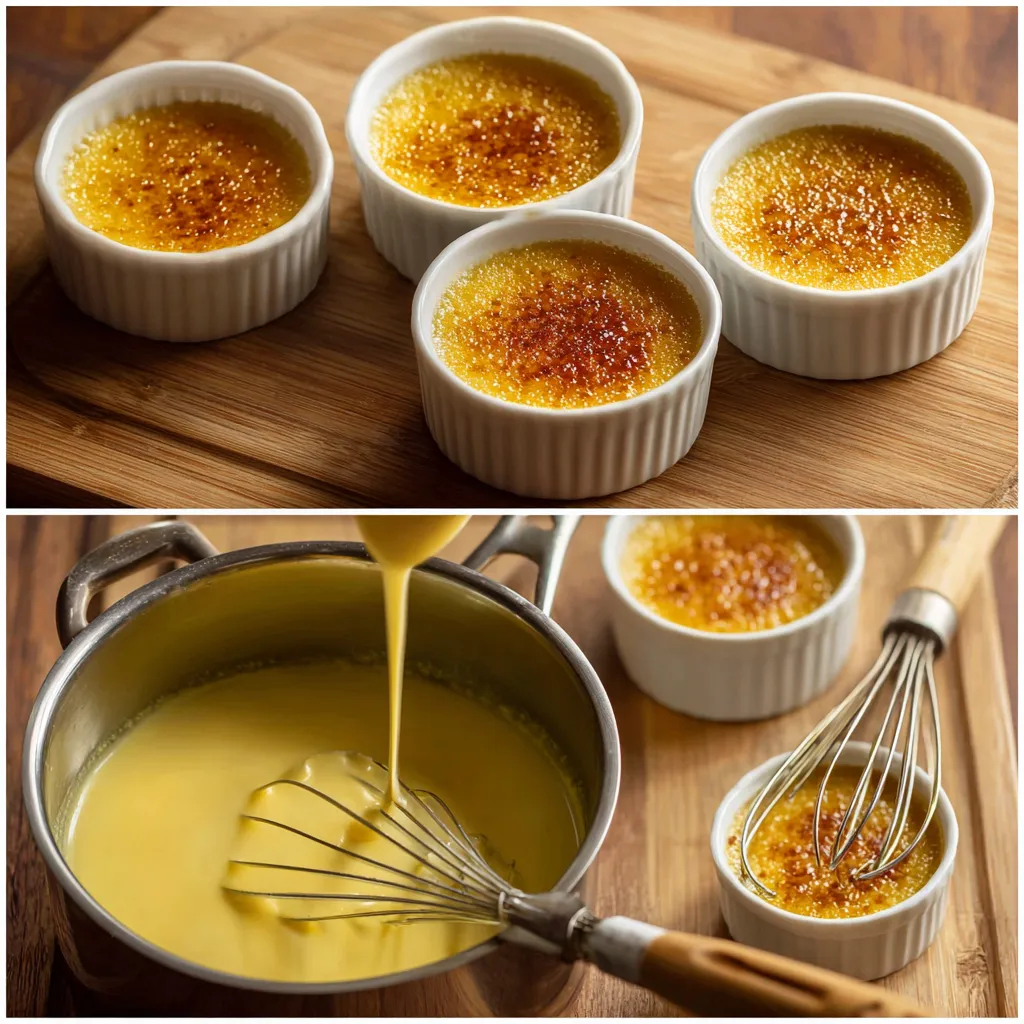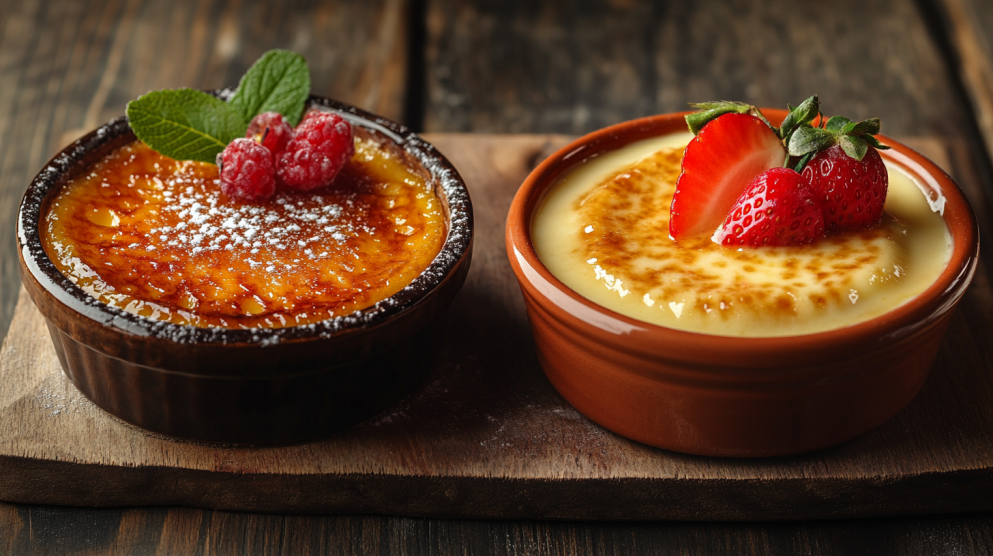What’s the difference between crème brûlée and custard? It’s a common dessert question — especially when both share a creamy texture and a sweet finish. While they may look similar on the surface, they’re surprisingly different in taste, technique, and presentation.
The short answer is this: crème brûlée is a type of custard, but not all custards are crème brûlée. Let’s break down exactly how they compare, and why each deserves its spot on the dessert table.
Table of Contents
Crème Brûlée vs Custard at a Glance
Here’s a quick side-by-side look to satisfy your curiosity immediately:
- Crème brûlée is a baked custard topped with a layer of caramelized sugar, usually torched until crisp.
- Custard is a broader category of desserts made from eggs, milk (or cream), and sugar, and can be served firm or pourable.
So yes, crème brûlée is custard — but it’s a very specific (and fancy) version.

They Share the Same Roots
The reason people often confuse them? It’s simple: they start with the same foundation.
Both are made from:
- Egg yolks
- Dairy (milk or cream)
- Sugar
- Often flavored with vanilla
Custard is one of the most ancient and flexible desserts in the world. Its earliest forms go back centuries — from medieval Europe to modern bakeries. Crème brûlée simply builds on this tradition with its signature torched topping.
What Exactly Is Custard?
Custard is a general term for desserts where eggs thicken milk or cream.
Common Types of Custards:
- Pastry cream: thick and used in tarts or eclairs
- Baked custard: like flan or custard tart
- Stovetop custard: like pudding or crème anglaise
- Frozen custard: churned like ice cream, with eggs
Its texture ranges from silky and pourable to firm and sliceable, depending on the method used.
So Then, What Is Crème Brûlée?
Crème brûlée is a rich, oven-baked custard typically served in ramekins. What sets it apart is that unmistakable, hard sugar crust on top — a layer that gets melted and crisped just before serving.
The Highlights:
- Made with heavy cream, egg yolks, sugar, and vanilla
- Baked in a water bath (bain-marie) for even cooking
- Chilled before serving
- Sugar on top is torched until crisp — brûlée literally means “burnt” in French
That crack you get when tapping your spoon on the caramelized top is part of what makes crème brûlée so special.
Craving something more adventurous? Try this crab brûlée recipe guide — a savory spin on the classic.
Texture & Taste Differences
So, what’s the difference between crème brûlée and custard when it comes to texture?
- Crème brûlée: Ultra-smooth interior, with a thin, hard caramelized top. Richer due to heavy cream.
- Custard: Depends — can be runny (like sauce), creamy (like pudding), or firm (like flan). Typically milder in richness if made with milk.
The contrast in crème brûlée — cool creamy base + warm crunchy topping — makes it a sensory standout.
Cooking Methods
Another major difference lies in how they’re cooked:
- Crème brûlée: Always baked in a water bath, cooled, then topped with sugar and torched.
- Custard: Can be cooked on the stove (like pudding), or baked. No topping involved.
Also, crème brûlée requires more equipment — like a blowtorch or broiler to achieve that iconic top layer. Custards, on the other hand, can often be made with just a saucepan and whisk.
Craving something more adventurous? Try this crab brûlée recipe guide — a savory spin on the classic.

Nutrition Differences
Because crème brûlée is made with heavy cream, it tends to be:
- Higher in fat and calories
- Richer and more indulgent
Custards made with whole or skim milk may be lighter — especially if they’re not topped with sugar or served with crusts.
But both are egg-based, naturally gluten-free (unless served in pastry), and can be portioned small for moderation.
Which One Should You Make?
If you’re choosing between the two for dessert, ask yourself:
- Want something fancy to impress guests? Go with crème brûlée
- Want a simple, versatile base for other desserts? Start with custard
- Prefer fewer tools? Custard wins for convenience
- Love a textural contrast? That sugar top on crème brûlée is unbeatable
There’s no wrong answer — just different delicious paths.
For a completely different approach to creamy desserts, explore this no-bake cottage cheesecake — no oven required!
Frequently Asked Questions
Q: Is crème brûlée just custard with sugar on top?
Pretty much! It’s a baked custard with a caramelized sugar topping, served chilled.
Q: Can I make crème brûlée without a torch?
Yes — use your oven’s broiler to melt and caramelize the sugar.
Q: What’s the difference between crème brûlée and flan?
Flan has caramel syrup on the bottom, flipped upside down. Crème brûlée has a burnt sugar crust on top.
Q: Can I use milk instead of cream in crème brûlée?
You can, but it won’t be as rich. It’s better to use at least half cream.
Q: Which is easier for beginners?
Custard. It’s more forgiving, and doesn’t require specialized tools like ramekins or a torch.
Final Thoughts
So, what’s the difference between crème brûlée and custard? Now you know:
Crème brûlée is a rich, oven-baked custard with a caramelized sugar crust — luxurious and textured. Custard is the foundation — a flexible, delicious dessert in many forms.
Whether you want something easy or something elevated, there’s a custard out there calling your name.
For more feel-good, no-fuss recipes that actually deliver on flavor, let’s stay connected:
📸 Follow along on Instagram for step-by-step reels
📘 Join the community on Facebook for comfort food discussions
📌 Save your favorites on Pinterest and build your go-to recipe board
I share weekly inspiration, behind-the-scenes tips, and creative spins on the dishes you already love. Your next favorite recipe might be just a scroll away.

